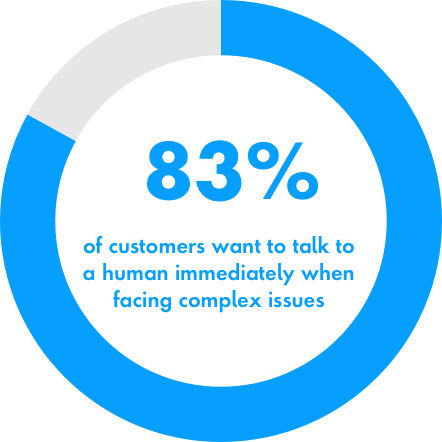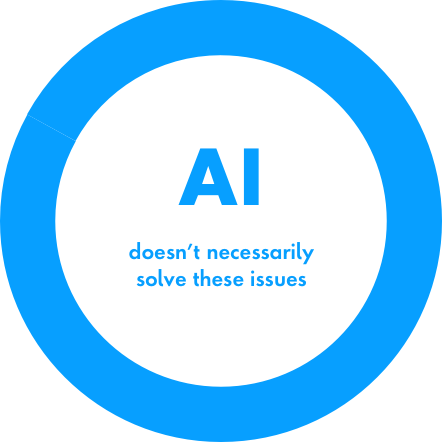What issue can we solve for you?
Type in your prompt above or try one of these suggestions
Suggested Prompt



Your Call Is (Not) Very Important To Us.
Artificial intelligence, self-service and automation have the power to cut customer service costs and improve the customer experience at the same time. So why is customer support still so frustrating?
Why do most call center systems repeat the phrase “your call is very important to us,” only to immediately put customers on hold for 5,10 or 20 minutes?
These moments of customer service frustration, whether they’re during games of cross-department phone tag, via cryptic self-service platforms or in endless loops of chatbot conversations, have become dreaded hallmarks of customer support operations across industries.
More often than not, as companies integrate new technology into customer service, it’s at the expense of both customer and employee experience (CX and EX). But if CXOs were to re-think technology integration from the customer’s point of view, they could turn customer support into a point of competitive differentiation while cutting costs at the same time.
"When customers are put on hold, they may feel that their call is not important. Even a brief hold at the wrong time can seriously degrade a customer’s experience and diminish how they perceive a company.” says Jennifer Borchardt, Vice President of Experience for Financial Services at Publicis Sapient. “Efficient and responsive customer service is an important investment and a critical aspect of customer – and employee – experience. Good experiences increase profits, promote brands, and drive loyalty".
"Efficient and responsive customer service is an important investment and a critical aspect of customer – and employee – experience. Good experiences increase profits, promote brands, and drive loyalty."
Jennifer Borchardt, Vice President of Experience for Financial Services at Publicis Sapient

The impact of customer support operations
Customer service, whether it’s self-service or a human interaction, is often the most salient touchpoint of the entire customer journey. And in many cases, it only becomes part of the CX journey when things go wrong. These are the biggest opportunities for brands to make an impact on their customers.
“CX teams should start by focusing most of their efforts on the most complex use cases. By solving the most complicated problems while you have the most time and energy, you’ll have the greatest impact on the overall customer experience and find that you are more easily and quickly able to address the remaining, simpler cases. This approach enables teams to invest their resources where it matters most and get the greatest return on this investment,” says Jennifer Borchardt.
For example, the customer booking journey for flight tickets is relatively straightforward, and even re-booking or upgrading a flight requires just a few clicks. But when it comes to anything slightly more complex, like switching the passenger name or getting a refund after a cancellation, the most efficient resolution for customers is often making a direct phone call.
During a widespread crisis, like inclement weather or worker strikes, airline customer service call centers aren't prepared for the volume or complexity of requests, which can turn a single event into the loss of hundreds of customers.

Self-service options come into play
However, the impact of customer support isn’t just limited to direct customer conversations. When used correctly, digital self-service tools are a fundamental necessity for the customer experience, especially for younger generations.
In fact, more than half of customers actually prefer self-service technology for simple issues like clothing returns, booking changes, or disputing charges. But 83% of customers expect to speak to someone immediately when they contact a company for more complex issues.
For example, Amazon’s retail self-service product return guides customers through identifying which items they’d like to return, how they’d like to return them and the process of getting a refund, all without having to wait to contact an employee.
But in many cases, self-service technology doesn’t hit the mark for customer support expectations, especially when brands remove the option to speak to an associate on the phone entirely. One American airline replaced all call center service with chat service, either through the airline’s app or website. This move requires a very complex customer service journey and a robust content strategy to back it up.
“Some brands have moved to self-service a little too quickly and a little too thoughtlessly,” says Jackie Walker, retail experience strategy lead at Publicis Sapient. “They’ve taken away traditional customer service channels with the expectation that all customers can do it for themselves. But if self-service is not in a mature state, customers are forced to solve their problems without the proper tools to do so.”

“Please listen carefully as our menu options have recently changed.”
At the same time, more expensive and traditional customer service channels, like call center systems, are still a CX challenge. This stems from the fact that call support is designed around business functions rather than customers and employees.
“If a customer’s problem is complex enough that they’re reaching out to call you, it probably doesn’t fall neatly into a call directory category,” says Walker. “Which means they’re probably going to be transferred multiple times to solve their issue.”
For example, many banks have separate departments to handle lost or stolen cards, fraud, forgotten passwords, etc.. Customers often need to handle issues that don’t fall neatly into one department but, at the same time, don’t want to speak to multiple departments to solve their problem.
In fact, 83% of customers expect to solve complex problems after talking to just one person. Typical call center systems often leave the employee on the other end of the line at a disadvantage, too.
In many cases, customer support teams don’t have access to the right customer information without transferring to another department, speaking to a supervisor or accessing several different systems while the customer is waiting.

“I would like to speak to a person.”
Integrating artificial intelligence, like generative AI model GPT-4 or natural language processing tools, doesn’t necessarily solve these issues or reduce customer service operational costs. Without the right CX strategy, automated customer service tools have the potential to frustrate customers more.
“It’s a slippery slope when customers think they’re talking to a human and it’s really not,” says Sara Alloy, head of experience for retail North America at Publicis Sapient. “Because giving email or chatbot responders a humanistic quality works really well, but if there’s a lack of transparency from the organization for who you’re really dealing with, or if you have no way to access a real person, it could be potentially damaging.”
If companies use AI-based tools to replace human interaction and customers use them expecting to solve their most complex problems, the gap in expectations creates moments of customer service frustration, leading to negative feedback and often even more work for customer service associates.
Three New Ways To Optimize Customer Support Operations
1. Reinventing the Customer Service Journey
To effectively integrate artificial intelligence, self-service or any customer service channel into customer support operations, companies need to think of it as part of a holistic customer service journey rather than a method to cut costs.
“Just like e-commerce customer journeys, customer support is a product or a service as well, and you can decrease cost-to-serve and increase customer satisfaction,” says Walker. “Break that mental model that says customer support is a trade-off, because you can be optimizing everything at the same time.”
To start with journey reinvention, look at the data to see the types of problems customers are trying to solve through customer service, and think about how to best design a customer service journey around remediation for those problems across channels and digital touchpoints.
Example: One insurance company completely transformed their approach to customer success through investing in a new data-driven, customer-centric support journey. The project started by analyzing the intent of customer service calls and creating more interactive self-service options like chatbots or informative videos to solve simple issues. Then, the company also created proactive customer touchpoints for common calls, like detected fraud or payment reminders. Not only did this new customer support journey help increase employee morale because employees could focus on deepening relationships, but it also increased customer satisfaction and reduced costs at the same time.
However, a new journey like this only works if all the employees on the other end have the tools to provide more robust, personal service.
2. Connecting the Customer and Employee Experience
In many cases, customer service frustrations stem from a lack of employee resources and investment, whether that’s technology or employee training. If companies create customer service journeys that parallel employee experience journeys, they’ll be much more effective in reducing cost to serve.
“Technology alone cannot improve experiences. It must be designed and implemented to account for how customer and employees will use it. Experience-centric technology is easier and more powerful for customers and employees, “says Jennifer Borchardt. “It gives employees the right tools and process to solve problems and access information while providing customers better ways to get help and help themselves. Good customer and employee experiences are connected.”
To combine customer service and employee experience, companies can start by looking at the customer service journey from an employee’s point of view. How many disparate systems do associates have to access to look up the right customer information and make changes to customer accounts?
Example: One bank consolidated 14 employee systems using a single overlay interface that pulled data from each system, allowing employees to access all customer service information in the same place. This reduced training time for new employees, significantly reduced overall employee turnover and decreased customer time-to-serve because employees could respond to and remedy issues much faster.
Redefining the customer service (and employee experience) journey also requires companies to redefine their KPIs and metrics surrounding customer service and how it shows up on the balance sheet.
3. Use Customer Success To Differentiate Your Brand
Historically, customer service support has been a “race to the bottom” because it functions as a cost center without much upside. Part of this problem is the metric that companies are using to define success: time to serve. Employees are rated on how quickly they can “resolve” customer issues or how many calls they can take during a shift, which doesn’t always incentivize resolution.
At the same time, customer experience, and particularly prompt and streamlined communications, aren’t viewed as profit drivers. However, around 9 in 10 customers believe that the experience a company provides is just as important as its products.
“Customer service success should be redefined to measure how frequently customer problems can be resolved on first contact, even if resolution might require that call to take more time.” says Jennifer Borchardt. “Resolving an issue on first contact can ultimately save time for both employees and customers in the long run since repeat calls are not needed, as well as increase satisfaction and trust. Research has shown that some customers who have had an issue successfully resolved report higher satisfaction than those who never experienced an issue at all.”
Example: One e-commerce company created a female persona to proactively reach out to new customers via email. As soon as a customer signs up or purchases a product, this persona proactively reaches out with an automated message and checks in with customers periodically throughout their purchase journey. In the future, if customers have problems, they can respond to this persona via email directly and, regardless of which associate is responding to the issue, the customer has a continuous, on-brand conversation.
Transform customer service into a differentiator
Now is the time for ambitious brands across industries to re-think their approach to customer service, harnessing new technology as part of an end-to-end service journey from the point of view of customers and employees.
Related Articles
-
![]()
Journey Reinvention Solution for Retail
Transform customer and partner retail journeys with Publicis Sapient’s Journey (Re)Invention solution. It provides a clear path to journey realization and identifies growth and cost-to-serve opportunities.
-
![]()
Employee Experience article - T&H
From experience platform design to customer journey mapping, applying a CX toolkit to digital employee experience can create personalized travel and hospitality experiences that build long-term guest loyalty.
-
![]()
Why Omnichannel Matters
Banks need to get better at creating omnichannel customer experiences. Discover how to up your omnichannel game.






